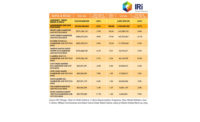Buns and rolls continue to emerge from ovens nationwide at a steady pace. While overall category growth has been minimal, several companies saw comparatively significant gains. And while traditional products maintain perennial allure, new interest comes from ingredients like whole grains and sweeteners.
Overview | Bread | Tortillas | Sweet Goods | Snack Cakes | Pizza | Desserts | Cookies | Buns & Rolls | Bars | Breakfast Products
Market data
Like other areas of bread, private label leads the charge in buns and rolls. Private label entries in the aggregate led both the hamburger and hot dog buns and “all other” fresh rolls/bun/croissants segments—both subsets of the fresh bread and rolls category. Overall, the hamburger and hot dog bun market grew 0.71 percent in dollar sales to $2.03 billion, while the all other fresh rolls/bun/croissants grouping grew 3.11 percent to $2.05 billion, per IRI, Chicago, for the 52 weeks ending April 17.
In hamburger and hot dog buns, private label sales fell 2.39 percent to $842.6 million, followed by Grupo Bimbo, which fell 2.41 percent to $456.7 million. Flowers Foods gained 0.29 percent to $247.7 million. The fastest-growing brand was King’s Hawaiian, up 56.99 percent to $28.3 million. Campbell Soup Co., owner of the Pepperidge Farm brand, also saw nice growth, up 22.2 percent to $79.1 million. United States Bakery (Franz), up 15.91 percent to $31.3 million.
For the “all other” category, private label dollar sales rose 1.26 percent to $521.9 million, followed by King’s Hawaiian, up 13.63 percent to $400 million. Bimbo was up 0.5 percent to $398.3 million. The fastest-growing business came from Campbell Soup, with its Pepperidge Farm products up 17.87 percent to $106.7 million. H&S Bakery was up 10.76 percent to $20.8 million.
Looking back
The miniaturization of products across the food industry surfaces in buns and rolls via slider-style products, an trend that has worked in the favor of King’s Hawaiian. Multiple other bakeries have found success with slider buns, including the Pepperidge Farm, Pan-O-Gold brand Village Hearth, Cobblestone Bread Co. from Flowers Foods and the Aunt Millie’s Hearth brand.
Like we have seen in other bread categories, artisan-style buns and rolls, including pretzel versions, continue to build diversified interest. Another area of potential growth in buns and rolls is organic and gluten-free—areas that have driven incremental growth in other fresh bread segments. While top requests in buns and rolls usually revolve around whole-wheat or whole-grain, says Brent Miller, director of marketing, ADM Milling, Overland Park, KS, he hasn’t seen much activity in buns and rolls.
“I don’t want to say it doesn’t have as much innovation,” says Miller. “But the picture looks the same as a year ago. I don’t think there’s been a dramatic change. You’re seeing some whole-wheat, multi-grain. Those would be the two that jump out, from a health perspective.”
At foodservice, limited-service formats that make use of buns and rolls grew to varying degrees during 2015, according to Technomic’s “Top 500 Chain Restaurant Report” for 2016. Chicken-based formats saw 8.6 percent growth, bakery-cafés 6.7 percent, burger restaurants 3.3 percent and sandwich chains 2.7 percent.
Multiple quick-service restaurant chains have recently introduced new buns, including Jack-in-the-Box and its “gourmet signature bun” used with the Buttery Jack burgers. Wendy’s also released new “bakery-style” buns for its burgers, described as “lighter” and “fluffier” than the old bun. Chick-Fil-A is introducing a gluten-free bun that comes wrapped in plastic and costs an additional $1.15.
Looking forward
Buns and rolls are following the same path as bread overall, says Keith Seiz, vice president of operations, The Arland Group, which represents the National Honey Board. “You have to look at the bread industry to see where the bun-and-roll industry is going,” he says. Five or 10 years ago, the bread category started to expand into whole grains and different seed varieties when consumer demand focused more on better-for-you, more healthful options, he notes. “That transformed the bread aisle. It had been 80 percent white bread, and now it’s flip-flopped, and whole-wheat breads are the norm. We’re seeing a lot more bun products that are 100 percent whole-wheat, and bakers are turning to honey. It allows them to maintain their natural, clean-label protection.”
Consumers are willing to expand their palates and pay higher price points if it means cleaner labels, Seiz says. “People are looking to clean up labels, even on buns and rolls, and remove ingredients that they don’t have in their pantries from the foods they buy.”
Clean-label can prove challenging to implement, says Angie Singer, director of sales and marketing, Delavau Food Partners, Philadelphia. “Reformulating to rid labels of ingredients that consumers are skeptical of, while still retaining the indulgent experience of enjoying a baked good, is key to our customers,” she says. “People are also seeking healthy indulgence from their favorite foods—they don’t just want to eat food that tastes good, they want it to be good for them, too.”
One approach to adding better-for-you value is fortification, such as incorporating calcium into a bun or roll, Singer says. “Especially for those who can’t or choose not to consumer dairy, this is a great way to deliver important nutrition, especially to children.”
Healthier choices means including whole-grain flours and reduced sugar content, says Jose Luis Gutierrez, technical support and R&D manager, Bunge North America, St. Louis. “One of the trends that we’ve been working on at Bunge is high-fiber formulations—specifically, balancing formulations to achieve the optimum equilibrium between high-fiber content and excellent baking performance. Ancient grains, for instance, can be a very good source of dietary fiber, as well as deliver other nutrient benefits. They also allow product developers to play with new flavors, textures and colors.”
With this in mind, Bunge uses ancient grains like quinoa, millet and sorghum in a multitude of functional formats, Gutierrez says. “For rolls and buns, using an ancient-grain flour can help the product meet most gluten-free and non-GMO demand, while delivering vitamins and minerals that align with the trend of balancing health and indulgence,” he says. “Bunge’s ancient grains can be blended with whole-grain flours as a pre-mix for baking products.”
The move toward clean-label is a necessary component of meeting the needs of select shopper demographics—but without sacrificing flavor and eating quality. “We work collaboratively with partners to implement solutions that allow them to maintain the eating experience of their rolls, buns and other baked goods, while appealing to the end-consumer who is concerned about certain less-familiar ingredients,” says Singer. “So much of bakery—from your favorite hamburger bun to the dinner roll you enjoy with your meal—is about a delicious eating experience.”
Overview | Bread | Tortillas | Sweet Goods | Snack Cakes | Pizza | Desserts | Cookies | Buns & Rolls | Bars | Breakfast Products









